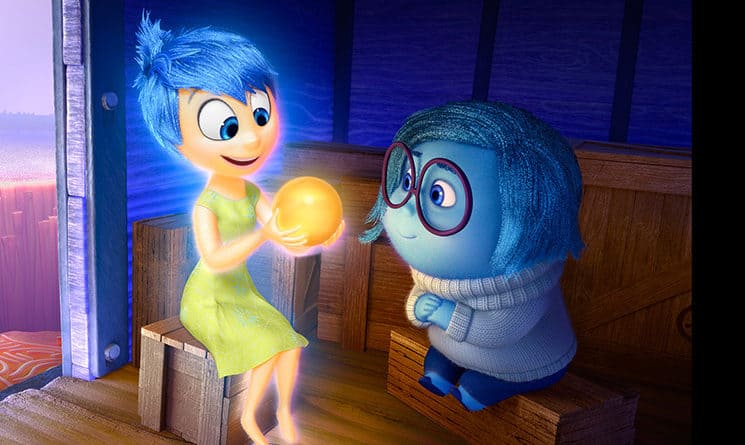One of the cardinal rules of storytelling is “Show, don’t tell.” The idea is that telling your audience a character is depressed is much less interesting than seeing that character mope about in the rain while listening to some sad music. It’s the sort of cinematic shorthand we’re all familiar with. Sometimes, when the talents of an actor, director, screenwriter, composer, and dozens of others mesh perfectly, showing those emotions can reveal an amazing depth of character. When those talents don’t align, we get the point anyway and move on.
“Inside Out,” Pixar’s latest animated film, takes the idea a step further. Instead of showing a character experiencing emotions, why not show the emotions themselves? And why not show how those emotions interact with memory and imagination, all of which work in concert in determining how a character — and how we — interact with the rest of the world? It’s an idea that’s awesomely ambitious and prime fodder for disaster. Given Pixar’s track record, and the resume of Pete Docter, who co-directed the film and created the story with Ronnie del Carmen, it’s somewhat unsurprising that “Inside Out” is a triumph. But even that undersells how great the movie is. Like many of the films that come out of Pixar’s studios, it’s smart and funny, interesting for kids and adults. But “Inside Out” is also bracing, a 94-minute shot of pure empathy that demands your full attention and engagement.
As the film opens, we meet Riley — a cooing newborn whose two primary emotions are Joy (Amy Poehler) and Sadness (Phyllis Smith). They work in Headquarters, where they direct Riley and watch as she forms memories. Riley grows and develops a personality. She’s goofy and honest, and loves her parents, friends, and hockey in equal measure. Other emotions arrive: there’s Disgust (Mindy Kaling), Fear (Bill Hader), and Anger (Lewis Black), all of whom take turns operating the control panel that determines how Riley’s feeling. Every interaction creates a new memory, represented here with spheres colored to correspond with each emotion — yellow for Joy, blue for Sadness, red for Anger, and so on. The emotions all want to keep Riley safe, healthy — and, most importantly for Joy — happy.
But Riley finds happiness hard to come by when her family moves from Minnesota, where she has friends, a place on a winning hockey team, and 11 years worth of fond memories, to San Francisco, where she finds a dead rat in her new living room and there’s always broccoli on pizza for some reason. The five emotions work to keep Riley steady, but trouble is afoot. Sadness accidentally turns some of Riley’s happy memories sad. And when it seems like Sadness is about to irrevocably turn Riley’s joyful core memories of her family and life in Minnesota into melancholy remembrances, Joy tries to stop her — and winds up getting both of them, and Riley’s core memories, stranded far away from their headquarters.
The action in much of “Inside Out” takes place in Riley’s mind, a brightly-colored, meticulously-detailed landscape. It’s rendered so well, and such a joy to explore, that it puts most other cinematic world-building efforts to shame. Guided by Bing-Bong (Richard Kind), Riley’s childhood imaginary friend now consigned to the depths of her memory, Joy and Sadness travel from the labyrinth of Long Term Memory, where nightly patrols vacuum up old memories like phone numbers, but keep annoying commercial jingles, to Imagination Land, where there’s a neighborhood dedicated to interpreting cloud shapes and a machine that creates ideal boyfriends.
There are other great details, too, but telling them all is boring. Docter, who previously wrote and directed “Up,” and del Carmen, along with screenwriters Meg LeFauve and Josh Cooley, have made a movie where almost all the action is abstract and all the stakes are, by the standards of summer blockbusters, incredibly low. Riley is never in physical danger, and neither are Joy and Sadness. And yet, every moment in “Inside Out” is vital. Docter and del Carmen make us care for Riley just as much as the five emotions do — and they manage to make us care just as much for those abstract representations, too. There are glimpses at the inner workings of other characters’ minds as well, and as a result, everything that happens in “Inside Out” feels monumental because it is monumental — every interaction, every memory, every feeling is bound up in an infinite chain that connects to every person we meet and their memories and feelings, and on and on. It’s a profound lesson in empathy and psychology and acceptance that also happens to be hilarious and joyful and melancholy, all at once.
Much of that credit goes to the cast. Poehler and Smith are veterans of NBC comedies “Parks and Recreation” and “The Office,” respectively, and it’s hard not to look back at their runs on those shows as a long practice for “Inside Out.” Poehler brings some of her Leslie Knope energy to the role of Joy, a Tinkerbelle-esque sprite who might be annoying if she wasn’t so likable, and Smith gives Sadness the necessary depth that makes her late-movie transformation into a hero satisfying and believable. Kaling, Hader, and Black are all great, too, and give “Inside Out” some important comedic energy. In a season when major studio movies ask audiences to turn off their brains for a few hours, “Inside Out” demands we think and feel deeply. It’s an ambitious request, and we could use more like it.

